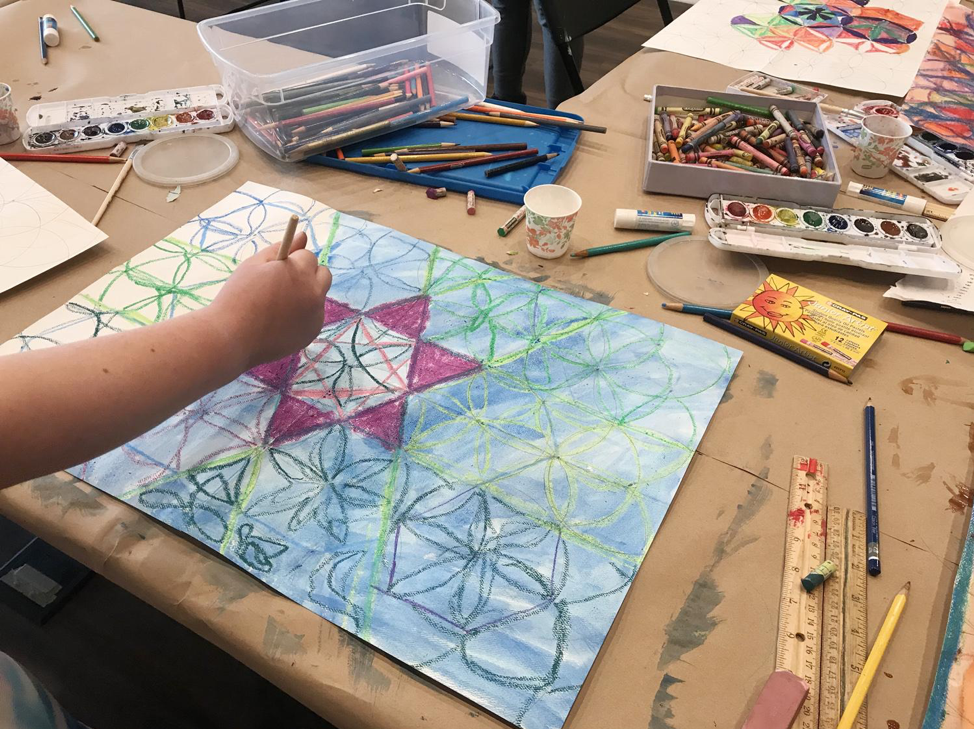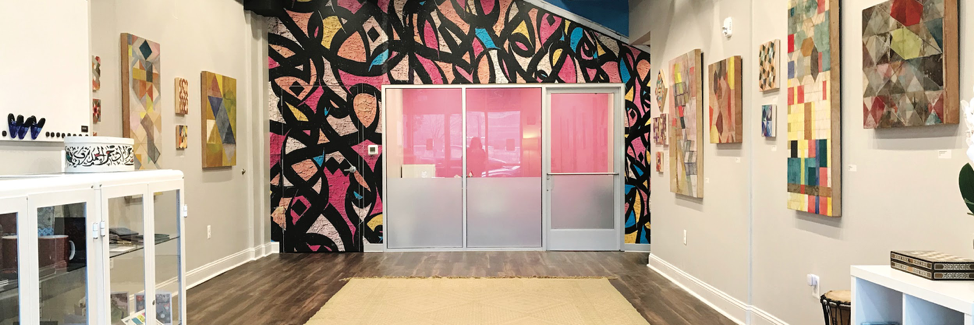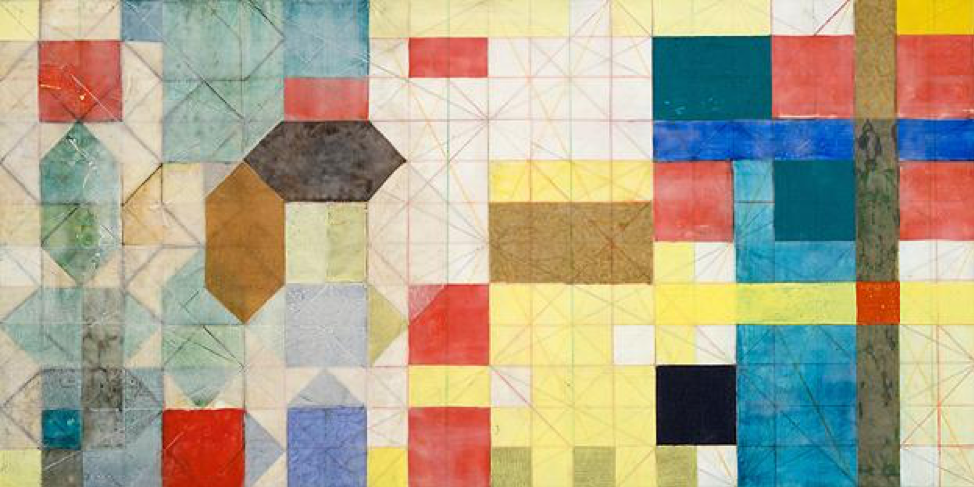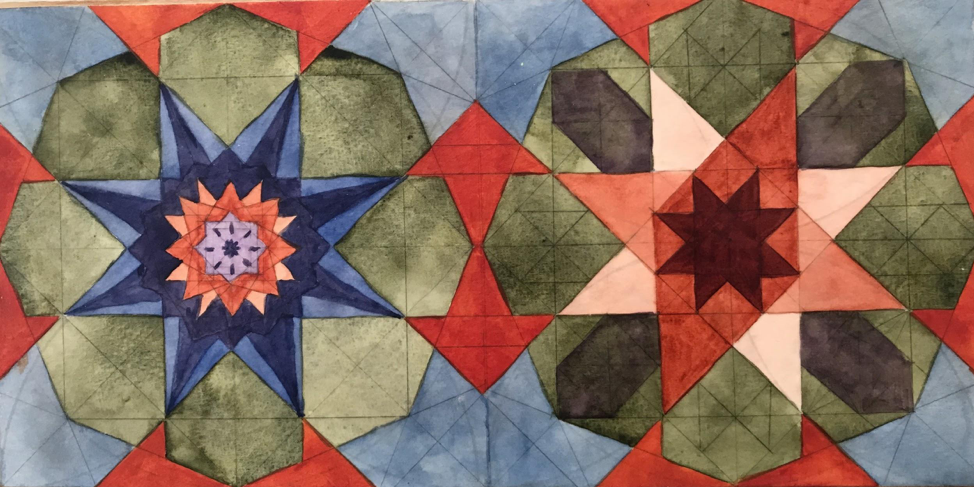
How do you engage with an ancient art form that continues to be practiced today? What does it mean for a contemporary artist to make use of sacred mathematical tools and techniques that are more than a thousand years old?
Tremain Smith’s Waxing Geometric reveals her long-held appreciation for Arab/Islamic art and a deep relationship with geometric forms borne out of her own explorations and her work over many years with Al-Bustan Seeds of Culture. This exhibit is on view until March 11, 2020 at Al-Bustan’s hub located at 3645 Lancaster Avenue in West Philadelphia.

Smith has always been fascinated with grids, so being drawn to Islamic art forms was no surprise. As she notes, “I used a grid prior to working with Al-Bustan, but it was my teaching with Al-Bustan that moved me to study Islamic Art in depth and this study greatly influenced my work in the studio.” Her work with Al-Bustan as a Teaching Artist in school programs and summer camp deepened this exploration. As she researched and honed her understanding of Islamic Art to bring into the classroom, her own practice was informed by these new techniques and approaches.
“Before her exploration of geometric forms, Smith’s work was steeped in encaustic. A centuries-old process, encaustic involves the layering of heated beeswax, resin, and pigments to form a paste that is applied on to a surface such as a wood panel or canvas. “
Before her exploration of geometric forms, Smith’s work was steeped in encaustic. A centuries-old process, encaustic involves the layering of heated beeswax, resin, and pigments to form a paste that is applied on to a surface such as a wood panel or canvas. Encaustic allows room for fluidity on to the work. Fusing geometric forms and wax, the exhibit is appropriately titled Waxing Geometric.
“I started working in encaustic 25 years ago because I wanted to be able to layer and collage with oil paint. I tried some cold wax medium and it took too long to dry. So I picked up a cake of beeswax and experimented. There was very little information on encaustic then, so I taught myself,” Smith shared. Her work involves collaged geometric shapes, preserving and separating the essence of each layer. She has four works of art in the permanent collection at the Metropolitan Museum of Art in New York City and has been featured in the encaustic art publications: Encaustic in the Twenty First Century and The Art of Encaustic Painting Contemporary Expression in the Ancient Medium of Pigmented Wax.

Earlier in February 2020, Smith led a Mixed Media Workshop designed for family participation. It was a joyful, intergenerational event. Youth and adults constructed their own six-point rosette, from which they identified various patterns and colored with different mediums. Participants were able to study and apply the complexity of the grid and repetition in their work, while also learning about recurring motifs and techniques in Islamic Art. Smith explained the significance of the “rosettes” in Islamic Art–a form that represents organic objects in nature. She said, “The seed is the beginning or foundation of the rosette which can expand infinitely in space,” therefore the rosette can imitate the germination of life and the universe’s infiniteness.

How are the geometric shapes related to organic forms in Smith’s works? She answers, “Soft and hard, fluid and straight-edged, precise and chaotic, the interplay between finished and unfinished, the balance of opposites: the geometry of the grid and gestural marks and drips. There is a rhythm to the filled space, the deliberate line or block of color, and the other spaces, the left-over splatter or haphazard stain, the loose intuitive lines. Both are at work side by side. Both are necessary to constitute the beauty of a painting.”

Smith’s artwork has captured the interest and imagination of visitors, workshop participants, art collectors, and many patrons who have come to Al-Bustan’s hub over the past three months. This inaugural exhibition has been a wonderful springboard for intuitive conversations, newly created artworks, and thoughtful insights into Arab art and culture.
“Rooted in Arab arts and language, Al-Bustan Seeds of Culture offers artistic and educational programming that enriches cross-cultural understanding and celebrates diversity through multidisciplinary programming.”
Rooted in Arab arts and language, Al-Bustan Seeds of Culture offers artistic and educational programming that enriches cross-cultural understanding and celebrates diversity through multidisciplinary programming. Keep a look out for Al-Bustan’s Friday Art Series, occurring every Friday ranging from music, poetry, film screening, and food! The annual Al-Bustan Camp is happening this July 2020, click here for more info.
Through March 11, 2020, Waxing Geometric is on display and artworks are for sale — 35 percent of sales support Al-Bustan Seeds of Culture.
An Encaustic Workshop for Adults is upcoming on Sunday, March 8, 1 – 4:00 PM.
Sahiti Bonam is the Marketing Coordinator at Al-Bustan Seeds of Culture, an arts and education organization in West Philadelphia. She got her BA in Visual Studies from Tyler School of Art, Temple University. She has a keen interest in amplifying art and cultural spaces for accessible use.

